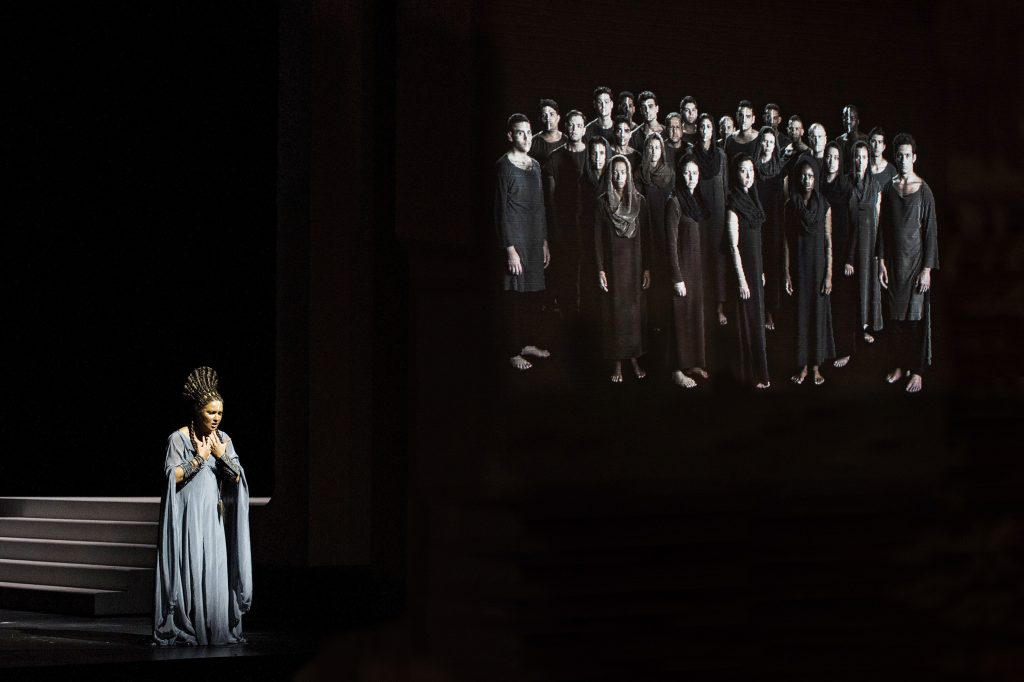
On Aug. 6, Riccardo Muti conducted his first staged opera at the esteemed Salzburg Festival since 2011 and the first production of Aida performed there in 37 years. “A historic time for the world’s most important music festival after having literally disappeared from its billboards, Aida returned to Salzburg with a dream team led by Muti at the podium with the Vienna Philharmonic,” wrote the Italian paper Il Messaggero the day after the opening performance. The production was easily the most anticipated of the festival’s centenary season with its stellar cast and new production catalyzing public attention. All seven performances sold out months in advance, and several celebrities were in the audience on opening night, from Angela Merkel to Plácido Domingo.
This new production was designed by the visual artist and Iranian exile Shirin Neshat. Muti was pleased with her timeless interpretation: “We worked together with a complete understanding,” he said in an interview. “It’s not the equestrian circus, it’s not a postcard of Aida,” he said, suggesting that if one was looking for a pastiche of pyramids and processions of elephants, one ought to look for a different production. Neshat’s design contains no exact locations or cultural references; rather abstract imagery and symbols suggest aspects of different religions and the shared plight of all refugees, “freeing the production from cliché,” as Valerio Cappelli of Corriere della Sera described it.
“The triumph is mainly in music, [the] power, the apotheosis of music, among the most extraordinary of Verdi’s symphonic pages. The rest can only be filled by the deep moods of the characters—no pyramids are needed,” said Muti to Il Messaggero. “The greatness of Aida lies in the intimacy of the many scenes often dominated by a single character, or two or three, who converse and collide as in the crucial Aida/Amneris relationship between two cultures, religions, [and] different races. . . . Verdi always touches on current topics concerning the past, the present and the future.”
Critics agreed that Muti’s interpretation was indeed able to bridge the gap between these colossal and the intimate paradigms. “Mr. Muti creates effects you didn’t quite think possible,” wrote Zachary Woolfe of the New York Times. “The phrases of the prelude at first seemed daringly separate and wispy, bits of metallic thread, before they began to weave together and almost physically coalesce. The span of Aida, from personal to the epic, was distilled in just a couple of minutes.” “[Muti] aims to precisely express the intimacy of the human drama: returning to Aida after forty years, has become so subtle and analytic that it reveals to us almost a new work,” read La Stampa. The article went on to say that, “the expression of feelings acquires an unprecedented complexity,” causing the listener to consider the intense personal emotions of the characters more thoughtfully against the pageantry of the triumphal marches in a production that is “reduced to the essence of human drama, in a bare and timeless environment.”
The all-star cast included soprano Anna Netrebko making her debut in the title role, tenor Francesco Meli as Radames, mezzo-soprano Ekaterina Semenchuk as Amneris, bass Roberto Tagliavini as the King of Egypt, and baritone Luca Salsi as Aida’s father, Amonasro. Meli and Salsi are familiar to Chicago Symphony Orchestra audiences from performances of Verdi’s Falstaff in 2016 (Salsi) and Macbeth in 2013 (Salsi and Meli). There was much anticipation for Netrebko’s debut in the title role. Her “scenic presence, powerful voice—dark and enveloping like black velvet” did not disappoint (New York Times). “With lavish voice in the dramatic song,” Netrebko’s interpretations of Aida’s many demanding arias were under the expert direction of Muti, with whom she has worked previously, for Puccini’s Manon Lescaut in 2014 at the Teatro dell’Opera di Roma, and more recently, in recital at the Ravenna Festival in 2015 (La Stampa).
Although it has been many years since Muti last conducted a production of Aida, he—“perhaps our finest Verdi conductor,” said the New York Times—has a long relationship with the work, having first conducted it at the Vienna Staatsoper in 1973. The following year, he made a recording of the opera for EMI with a cast starring Monserrat Caballé and Plácido Domingo with the New Philharmonia Orchestra and the Royal Opera Chorus.
There will be many TV broadcasts of this Salzburg production of Aida in Europe this summer, and American audiences can look forward to seeing it on DVD on a yet to be determined release date. After the final performance on Aug. 25, Muti will return to Italy to lead his Opera Academy in Ravenna from Sept. 1-14, where he will tutor young conductors in Verdi’s masterpiece.
TOP: Francesco Meli (Radames), Riccardo Muti (Conductor), Shirin Neshat (Director), Anna Netrebko (Aida), Luca Salsi (Amonasro). | © Salzburger Festspiele/Franz Neumayr
For more information, visit:
L’«Aida» ritorna con Muti. Dopo 37 anni l’opera va in scena a Salisburgo
A Salisburgo l’Aida di Riccardo Muti e Shirin Nesh contro ogni Guerra
- Giuseppe Verdi/Aida/ Premiere am 6.August 2017/Riccardo Muti:Musikalische Leitung, Shirin Neshat:Regie, Christian Schmidt:Bühne, Tatyana van Walsum:Kostüme/ Anna Netrebko:Aida,
- “Aida” premiere on August 6, 2017, with Riccardo Muti/conductor, Shirin Neshat/director, Christian Schmidt/stage director, Tatyana van Walsum/costumes Anna Netrebko as Aida
- Salzburger Festspiele 2017, Premiere of “Aida” at the Großen Festspielhaus Schlussapplaus Foto: Franz Neumayr 6.8.2017 Conductor Ricardo Muti and Anna Netrebko


